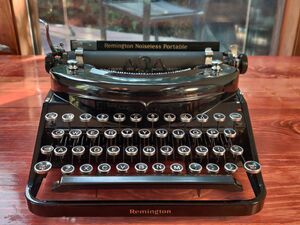Remington Noiseless Portable Typewriter
History and Basic Info
The Remington Noiseless Portable Typewriter (not to be confused with the Remington Noiseless Typewriter) was a Noiseless design sold by Remington in the 1930s-1940s. Underwood also branded Remington Noiseless Portable Typewriters and sold them under the Underwood name.
Common Issues
These typewriters often skip - adding extra spaces after letters typed. You can minimize it by typing very precisely as well as replacing the rubber strip that the key arms rest on beneath the keyboard. To do so, you must remove a metal bar that has four small screws using a thin screwdriver, and then remove the rubber strip. You will need a 1/8" by 3/16" replacement, or cut down a 1/8" by 1/4" rubber strip. Also, the current strip will be rock hard and often must be broken to remove. Be sure not to bend or dent the metal the strip is in.
This will only minimize the problem, as the mechanism that quiets these machines makes the skipping more likely.
